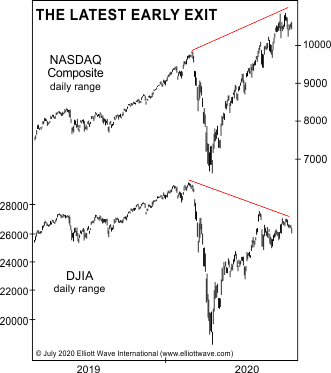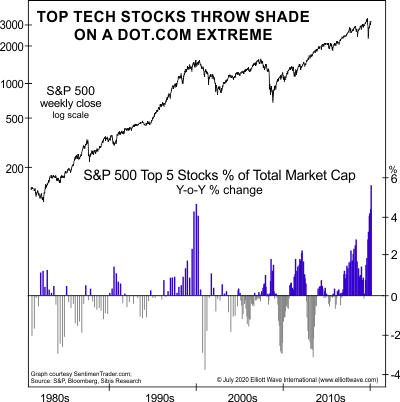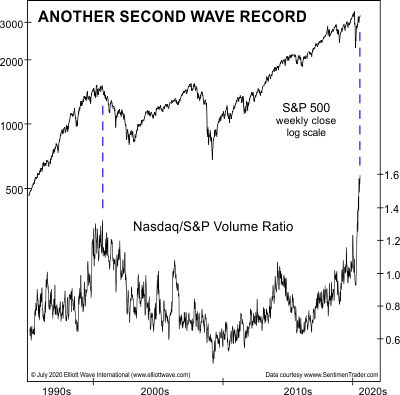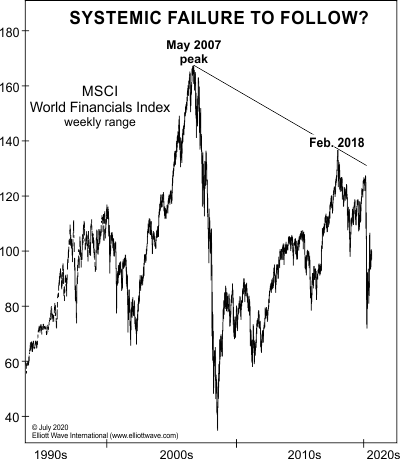NASDAQ vs. DJIA: Does the Recent Divergence Matter?
Stock-Markets / Stock Markets 2020 Aug 15, 2020 - 01:02 PM GMTBy: EWI
"The NASDAQ nearly doubled in the last 100 days of its rally."
This quote sounds like it's from 2020, doesn't it?
After all, since its March bottom near 6600, the NASDAQ has rallied to a new record high. Low to high, it has indeed "nearly doubled."
And yet, the quote above is not new. It's from the year 2000.
It appeared in Financial Forecast, a monthly publication by our friends at Elliott Wave International covering stocks, bonds, the dollar, gold, the economy and more.
Yes, the divergence between the NASDAQ and DJIA -- one makes a record high, the other one doesn't -- is something EWI’s analysts have seen before.
And today, the same divergence tells you a lot about the next move in stocks.
This excerpt from EWI’s August 2020 Financial Forecast explains:
Special Section
ANOTHER ICARUS MOMENT FOR THE NASDAQ
In December 1999, just weeks before the Dow Jones Industrial Average made its Primary wave 3 peak on January 14, 2000, the NASDAQ Composite was surging higher to ever more ecstatic reviews. "Ignore any forecast of the Dow," cried the pundits. The Elliott Wave Financial Forecast saw it differently: "When the NASDAQ (and predecessor the OTC Index) pushes into record territory against a lagging Dow, the overall market is late in a long-term uptrend. It is only after years of ascent that investors can work up the courage to jump into these relatively young names despite a weakening trend." In the January 2000 issue, when the Dow was days from its top, EWFF called the "languishing Dow and the ebullient NASDAQ a classic sign of long-term vulnerability for the market." The NASDAQ nearly doubled in the last 100 days of its rally. With the index just days from its peak, the March 2000 issue of EWFF issued the following forecast:
The NASDAQ's strength is derived from rotation among a thinning list of high-tech stocks. "The mentality is, 'Let's trim the generals [the Dow stocks] and put some of that money to work among the soldiers [the Nasdaq issues].'" Investors are so bullish that they will defy their own social nature to back a leaderless army. Such transgressions generally happen only late in long-term uptrends. The resulting carnage resembles what happens in a real war when the generals abandon the fight.
Similarly, after the Dow Industrials topped in December 1968, the OTC index rallied to a new high in November 1969, unconfirmed by the Dow. Overall, neither stock index made any material gains for another 13 years.

The chart above captures the latest divergence between the two indexes, which dates back to February 12 when the DJIA rallied to 29,551.42, its [so far] all-time closing high. The NASDAQ's closing high then occurred at 9817.10 on February 19. After declining in conjunction with the Dow to March 23, the ensuing rally carried the NASDAQ to new highs.
As in 2000, a "thinning list of high-tech stocks" accounts for much of the stock market's strength. The figure below shows that in June, just five technology stocks, Facebook, Alphabet (Google), Microsoft, Apple and Amazon, accounted for 5.7% of the S&P 500's year-over-year increase in total market capitalization, a new record. The prior extreme came at the major top in March 2000.

In July, the advance narrowed further to three main stocks, as approximately 23% of the S&P's gain came from Amazon, Apple and Alphabet (Google).
The next chart shows another area in which the NASDAQ recently surpassed a post-peak extreme from 2000. In early July, NASDAQ volume surged to 1.6 times S&P volume, the highest on record.
The prior record ratio of 1.35 occurred on September 5-6, 2000, when the NASDAQ and S&P 500 completed second-wave rallies in their respective bear markets.

There is an important difference between the peaks in 2000 and 2020. In 2000, financial stocks performed well, holding up for the balance of the year as the major stock averages declined.
The next chart reveals that's not the case now. On a short- and long-term basis, the MSCI World Financials Index is far weaker than the main stock indexes.

In this respect, current market behavior is more like 1968-1969. That is when financial entities struggled in the midst of an ongoing speculative orgy. Brokerage firms were privately held at that time, but in his book The Go-Go Years
In September 1969, two months before the peak in the OTC Index, NYSE member firm Gregory and Sons went under.
In December, only one month after the OTC top, Brooks wrote, "Depression had come to Wall Street. A cheerless pall of doom hung over the financial district through the 1969 holiday season."
A slew of failures in marginal firms followed. Even "conservative, well-established giants were in bad trouble. Bache and Company reported that for fiscal 1969, it had recorded the largest annual operating loss in the annals of American brokerage. Shock waves followed."
Back in 2014, market expert Ned Davis said, "If there are systemic risks, financials generally will ferret them out."
That observation remains as pertinent as ever.
Want to read more insights like this one -- free?
Then join Elliott Wave International’s free Club EWI today.
350,000 online members strong, Club EWI is your free source for tons of investor- and trader-focused reports, videos, forecasts and more.
Club EWI really is free, you won’t be asked for your credit card number. So, take a few seconds now to join in – and start reading and watching new insights. Get started now.
This article was syndicated by Elliott Wave International and was originally published under the headline NASDAQ vs. DJIA: Does the Recent Divergence Matter?. EWI is the world's largest market forecasting firm. Its staff of full-time analysts led by Chartered Market Technician Robert Prechter provides 24-hour-a-day market analysis to institutional and private investors around the world.
© 2005-2022 http://www.MarketOracle.co.uk - The Market Oracle is a FREE Daily Financial Markets Analysis & Forecasting online publication.



